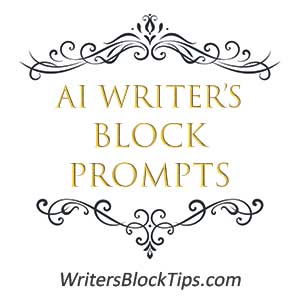5 AI Prompts to Get Rid of Writer’s Block – Advice for Writer’s Block
 Writer’s block is a familiar adversary for anyone who creates content. Whether you’re working on a novel, a blog post, or a research paper, feeling stuck can be frustrating and demotivating. Enter artificial intelligence (AI)—a modern tool capable of helping you overcome creative hurdles. Together we’ll explore 5 AI prompts to get rid of writer’s block, and reignite your creativity.
Writer’s block is a familiar adversary for anyone who creates content. Whether you’re working on a novel, a blog post, or a research paper, feeling stuck can be frustrating and demotivating. Enter artificial intelligence (AI)—a modern tool capable of helping you overcome creative hurdles. Together we’ll explore 5 AI prompts to get rid of writer’s block, and reignite your creativity.
Created by a former literary agent who’s helped 400+ authors get literary agents and/or traditional book publishers as an author coach/consultant, this article is part of a guide about How to Get Out of Writer’s Block.
AI for Writer’s Block
AI has revolutionized the way writers approach their craft. With advanced tools like ChatGPT, Jasper, and Sudowrite, writers can access a virtually endless stream of ideas, feedback, and inspiration. These platforms are designed to generate suggestions, help organize thoughts, and even refine prose. By offering creative prompts tailored to your specific needs, AI can help break through mental barriers and make the writing process smoother.
What makes AI particularly effective for writer’s block is its ability to analyze patterns in language, replicate human-like writing styles, and suggest innovative solutions. Whether you’re crafting dialogue, brainstorming plot twists, or drafting an essay, AI can function as a creative partner, offering prompts to get you unstuck.
Below, we delve into five AI-generated prompts designed to help you conquer writer’s block and reclaim your creative flow.
- “What if” Scenario Generation
AI excels at generating thought-provoking “what if” scenarios that can inspire creativity. Use AI to help brainstorm alternate realities, surprising twists, or unexpected character developments. Here’s how this prompt works:
- Ask the AI: “What if a character discovered a secret they weren’t supposed to know?”
- The AI might respond with: “Imagine a world where a character stumbles upon their family’s hidden involvement in a covert operation, forcing them to decide whether to expose the truth or protect their loved ones.”
This type of open-ended scenario not only sparks curiosity but also offers you a starting point to explore conflict, stakes, and character arcs. With endless possibilities, “what if” prompts can provide the push you need to develop a compelling story.
- Character-Driven Prompts
Characters are the heart of any great story, but developing them can be a challenging task. AI can assist by creating detailed prompts to help flesh out your characters, their motivations, and their relationships.
For instance, you could input: “Describe a conflict between two best friends where one feels betrayed.”
The AI might respond: “Two childhood best friends, Alex and Jamie, find themselves at odds when Alex secretly applies for Jamie’s dream job and gets it. How does Jamie confront Alex, and what does this reveal about their friendship?”
Character-driven prompts encourage you to dive deeper into the emotions, perspectives, and complexities of your characters, making it easier to move forward with your narrative.
- Sensory Detail Exploration
AI can help you focus on sensory details to create vivid scenes and immerse readers in your world. When you’re stuck, asking AI to generate prompts related to the five senses can provide the descriptive push you need.
Example: Ask the AI, “Help me describe a setting using sensory details.”
The AI might suggest: “Imagine a bustling city street at night. Describe the shimmering glow of neon signs reflected on rain-soaked pavement, the chatter of pedestrians blending with distant honking horns, the smell of street food carts wafting through the air, and the cool breeze brushing against your face.”
By zeroing in on sensory details, you can transform a stagnant scene into one brimming with life and texture, reigniting your creative momentum.
- Dialogue Jumpstarts
When your story is stalling, turning to dialogue can often help you regain traction. AI can generate conversation starters, conflicts, or exchanges that breathe life into your characters and propel the story forward.
Input something like: “Generate an intense dialogue between two characters who disagree on a moral issue.”
AI might produce:
“I can’t believe you’re defending them,” Sarah said, slamming her fist on the table. “They’re criminals!”
Mark leaned forward, his voice low but firm. “They’re human beings, Sarah. They made mistakes, just like we all have.”
“Some mistakes can’t be forgiven,” she shot back, her eyes flashing with anger.
This snippet offers tension and conflict, giving you a jumping-off point to continue writing. Dialogue prompts not only help develop character voices but also introduce conflict and action to your narrative.
- Plot-Twist Brainstorming
Nothing shakes off writer’s block like a good plot twist. AI can generate unexpected turns of events that add intrigue and momentum to your story.
Try asking: “What’s a shocking plot twist for a detective novel?”
The AI might respond: “The detective discovers that the serial killer they’ve been hunting is actually their estranged sibling, forcing them to confront a dark family secret while deciding whether to cover for them or bring them to justice.”
Prompts like these can provide the adrenaline rush your story needs to break free from stagnation. Plot twists keep both writers and readers engaged, making them a valuable tool for combating creative blocks.
Why AI Prompts Work
AI prompts are uniquely effective because they provide an objective perspective, free from the emotional and mental blocks that humans experience. They offer fresh ideas, unique perspectives, and a sense of structure when your thoughts feel scattered. Unlike brainstorming alone, AI serves as a collaborative partner, helping you generate ideas in real time.
Moreover, AI can be customized to suit your needs. Whether you’re looking for prompts tailored to genre, tone, or specific scenes, AI can provide suggestions that align with your creative vision. The immediacy and flexibility of AI tools make them an indispensable resource for any writer struggling to overcome writer’s block.
Conclusion – AI Prompts for Writer’s Block
AI-powered prompts are a game-changer for writers grappling with creative blocks. From generating “what if” scenarios to crafting dialogue, character conflicts, sensory details, and plot twists, these five AI prompts provide the tools you need to get unstuck and rediscover your creative flow.
By leveraging AI, you not only break free from writer’s block but also unlock new possibilities for storytelling, creativity, and productivity. So the next time you find yourself staring at a blank page, remember that AI is just a few clicks away, ready to help you turn your ideas into words.
Now that you’ve read “5 AI Prompts to Get Rid of Writer’s Block, click here to read “Writer’s Block Software.”

 This guide about
This guide about 